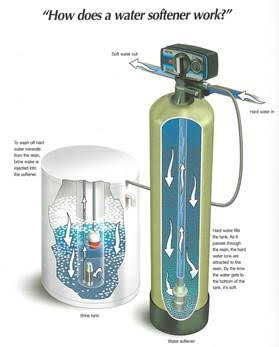FAQs
How do I bypass my Automatic Water Conditioning softener or filtration tank?
There are several different types of equipment that we offer. This description will guide you through the bypass instructions for the vast majority of our filtration systems. There are other bypass configurations that may not be described here. If you find the below instructions do not pertain to your system please call our office for further instructions.
To bypass most of our systems there is an individual bypass located on the back of the filtration system. Bypassing is as simple as turning the lever located on the back of the unit from “Service” position to the “Bypass” position 90 degrees in a counter clockwise motion. Please note the valve may be stiff and may require some effort to turn.
In Service Position pictured below:
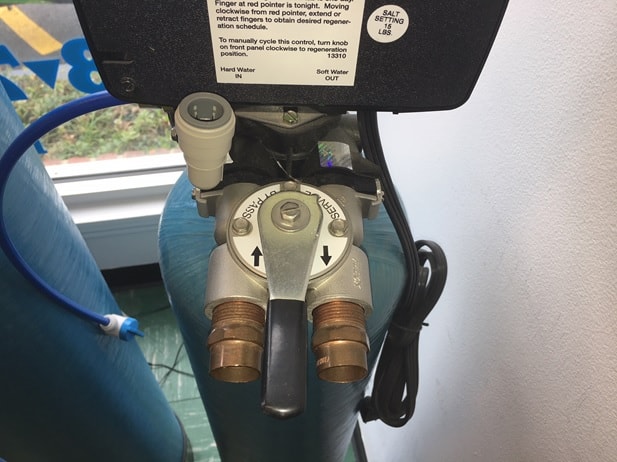
Bypass Position pictured below:
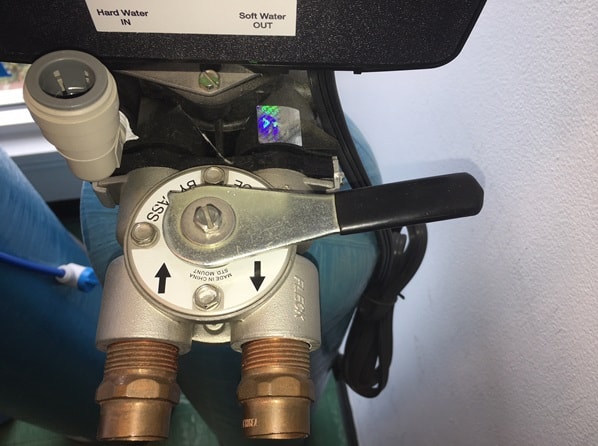
If your system does not have a bypass that looks like this you may have a bypass manifold that will required multiple valves to be turned. These will be piped in various ways depending on the manner into which they had to be installed but the principle is the same. There will be three valves that must be exercised. These may be gate valves or ball valves. Diagram pictured below. To bypass the system the inlet and outlet valves must be closed and the bypass valve must be opened. Gate valves are opening by turning counter clockwise and closed by turning clockwise until the stop turning. Ball valves are closed when the lever is perpendicular to the pipe and open when parallel to the pipe.
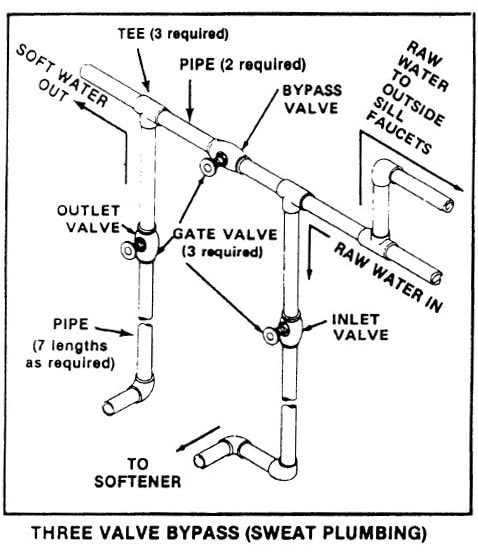
How do I reset the clock on my filtration equipment?
First, locate the control valve on top of the filtration system. This looks like a black box on top of what looks like a helium tank. On the front of the control will be a TIME OF DAY window pictured below.
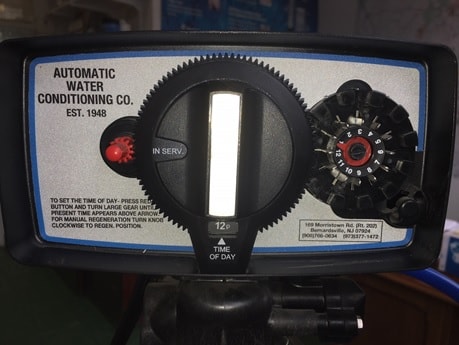
To change the time you will need to depress the red button (on the left side of the control pictured above) and hold it down. This will release the timer gear located on the OUTSIDE Center ring on the valve. Turn the timer gear by putting your finger on the black teeth on the center dial NOT THE CENTER OF THE DIAL WITH THE SILVER STRIP. This should turn with little to no effort, and as the outside dial turns the time of day window should change. This is usually set to the current time of the day. If it is 1pm this should be set to 1p. DO NOT turn the right 1-12 dial or meter not shown.
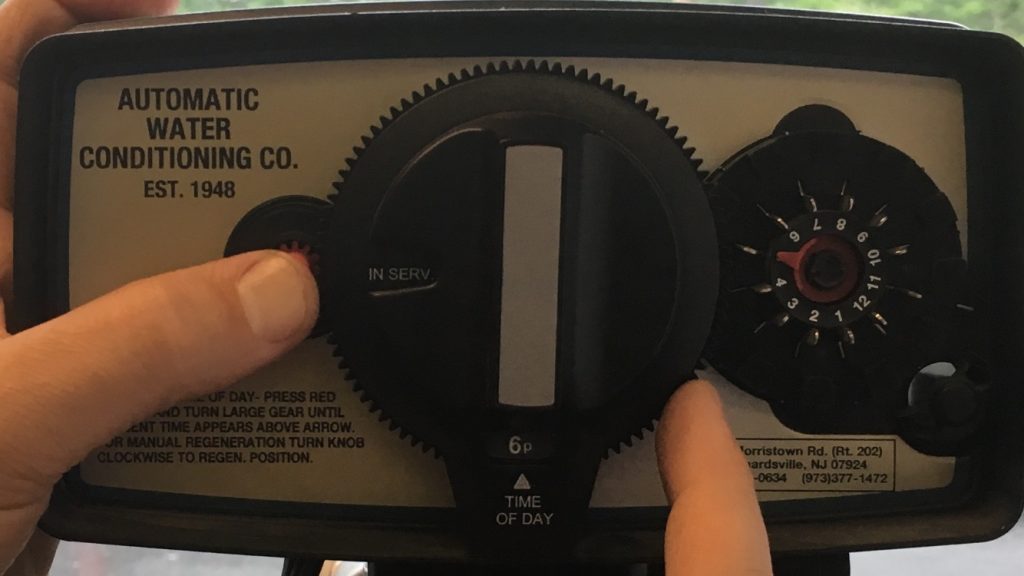
Note if you accidentally turned the center cycle dial during this process; you must turn this gear only in a clockwise manner to avoid damaging the control valve. The unit should show the cycle window as IN SERV on the timer gear when properly set.
If you have an electronic valve setting the time can be changed by simply holding the UP or DOWN arrow until the time begins to change. Set to the current time and press the cycle button to save the change.
I have brown water in the brine tank: What do I do?
Brown water in your salt tank can be caused by a couple things. Most commonly on well applications this is caused by iron present in the water that is used to make the brine solution in the brine tank. As the iron sits in the brine tank it oxidizes and the water will turn brown. This is normal and is nothing to worry about. Water does not actively pass through the brine tank, but only when the system regenerates.
Other causes of brown water in the brine tank can stem from impurities in salt being added to the tank. Over time these accumulate in the tank and will turn the water brown. If you would like your brine tank cleaned it is best to let the salt level get as low in the tank as possible before cleaning the tank to facilitate the cleaning and reduce the loss of salt. The brown water does not impact the function of the system.
My water filtration system is leaking. What should I do?
If your water filtration equipment is leaking you should bypass the filtration equipment with the provided bypass. Instructions on how to do this are above. If the leak is in the copper pipe or plumbing system a plumber may be required to fix the issue. If you cannot find the bypasses it is best to locate the main shut off on your water supply, turn off the water and call us or a plumber. To slow pin-hole leaks and after shutting off the water, it may be helpful to open the taps in the house to help drain water out of the pipes to slow the leaking of water draining back from the rest of the house.
My filtration system is flushing during the day. What do I do?
The water filtration system is programmed internally to regenerate in the middle of the night. However with power outages the clocks can lose time and the system can regenerate during the day. This is easily identified by checking the timer on the top of the system. If the system is making noise, and the clock displays a time between 12a-4a then the unit just thinks it is the middle of the night and is regenerating. This noise should never last more than 2 hours. If you have heard water rushing through the system longer than 2 hours or if the timer reads a time outside of the 12a-4a the system should be bypassed and we should be called for a service appointment. To correct the issue you can reset the timers by using the FAQ reset clocks instructions.
My tank is sweating: What do I do?
Your water softeners should be in a well-ventilated area. However, if that’s not possible a humidifier, condensation jacket or drip pan can address the problem. We have washable Neoprene Condensation jackets available to help reduce condensation. Just ask about them when setting up an appointment.
My water tastes salty. What do I do?
The water filtration system is programmed internally to regenerate in the middle of the night. However power outages can cause the clocks to lose time in which case the system can regenerate during the day. If water is being used during a softener regeneration cycle it is possible to pull some brine water through the system into the plumbing. This will typically clear by running water for several minutes at the taps where you experience the salt flavor. To correct the issue you can reset the timers by using the FAQ reset clocks instructions.
Salt is not going down in the tank, what do I do?
This can be caused by a few things. Some are common and relatively easy to identify. First check the clocks on the unit. They should read the current time of day. If they are off it is possible water usage is occurring during the regeneration process and may be affecting the regeneration cycle. Instructions for resetting the timer are located in the FAQ.
A temperature or humidity change can cause the salt to bridge. A salt bridge is a hard over-crusting of the salt in your brine tank covering or spanning over the water. This usually occurs seasonally going from hot to cold. Tap or shake the side of the plastic salt tank to loosen the salt and collapse the bridge. If neither of these situations applies it is time to call for a service appointment.
How much salt do I need in my salt tank?
How do I pay my bill?
You can pay by credit card by phone at 908-766-0634 (note: a 2-3% fee will apply), or you can send your check to: Automatic Water Conditioning Co., 169 Morristown Rd, Bernardsville, NJ 07924.
Do I need a Water Softener?
If you notice white stains, crust or etching on dishes, showers, or faucets or if your hot water heaters and appliances don’t seem to last as long as they should, you probably need a water softener. Dry hair and itchy, dry skin can also be the result of hard water. Hard water will also require more detergent or soap to achieve a sufficient lather to help clean skin and clothes.
Call 908.766.0634 or use our Contact Form to make an appointment with one of our experienced water technicians for a free water test and analysis.
Do water softeners negatively impact septic systems?
If the system is set properly and running efficiently then it will not negatively impact your septic system. It can actually improve performance of a septic system according to a study performed by the Virginia Polytechnic Institute and State University in conjunction with NOWRA, WQA, and NSF.
Does salt in the system impact my health?
According to the Mayo Clinic: “An 8-ounce (237-milliliter) glass of softened water generally contains less than 12.5 milligrams of sodium, which is well within the Food and Drug Administration’s definition of “very low sodium. Thus, it’s unlikely that sodium in softened water would pose a risk for most healthy people.” However, consult with your doctor if you are on a low sodium diet.
Should I use a metered water softening system vs. a timed system for cost efficiency?
A metered system, also called demand initiated, is the more efficient system because it regulates the softener by usage and not by time. For example, if you and your family are away for a two-week vacation, you will not need the system to regenerate as often as if you were at home. A timer based system will regenerate regardless of how much water you’re using.
Is there a system I can use to replace bottled water?
There are multiple systems that you can use to replace bottled water; from filtering systems to reverse osmosis, UV systems, activated carbon filters, and so on. Automatic Water Conditioning Co. can provide you with the know-how you need to make an informed decision.
Do I need an arsenic removal system?
There are two types of systems that can be used for arsenic removal:
1) point-of-entry treatment (POET) systems that treat the water for the entire household; and
2) point-of-use (POU) systems that treat the water at the kitchen tap.
We utilize several different technologies to remove arsenic from water; anion exchange, titanium oxide, and reverse osmosis. Automatic Water Conditioning Co. can help homeowners and business owners determine which system is best for removing arsenic for a given local geology, water chemistry and use of the water.
Do I need a reverse osmosis system?
Do I need an acid neutralizer?
A pH level of six or below indicates acidic water, which can corrode your pipes, appliances, fixtures and other key plumbing infrastructure from the inside out which can require expensive repairs or replacement. If acid water is a problem in your home, you do need an acid neutralizer sooner rather than later.
Do I need a carbon filter?
Do I need a sediment filter?
Sediment is not rare. If you have municipal water, periodic flushing of fire hydrants can stir up sediment in the water supply. You may have seen this in the bottom of your glass of water. This will clear by itself once the pipes are sufficiently flushed. However, some sediment may be a sign of other problems which may apply to municipal, well water as well as other ground water sources. Fortunately, successful treatment options are available and include whole house cartridge filters, filter strainers, and self-cleaning sediment filters among others.
Can my water pH be too high? (water alkalinity)
Moderate concentrations of alkalinity are desirable in most water supplies to balance the corrosive effects of acidity. However, excessive quantities cause a number of problems. Strong alkaline water has an objectionable “soda” taste and alkaline water can contribute to hard water problems.
My water smells like rotten eggs. What is it?
Water can smell for a number of reasons. First you should identify if the water smells on hot and cold taps. If the water smells on both hot and cold you can have bacteria or hydrogen sulfide present in the water and filtration equipment should be serviced adjusted or added. More commonly if the smell is just on the hot water this can be related to your hot water heater. Hydrogen sulfide can be produced by iron bacteria in the water, or by a reaction with anode rods in hot water heaters. Chlorinating your hot water heater may clear the issue, and you may also need to change the anode rod that is in the heater tank. Often magnesium anode rods can react with water making the odor stronger, and to combat this most hot water heater manufacturers make available different types of anode rods to minimize or remove this issue.
What type of salt should I use in my water softener?
We recommend coarse grain solar salt (sodium chloride) be used in our system. The higher the purity the better the performance and the lower the maintenance will be on the system. You should not put pellet salt in any of our water softeners. Pellet salt in our system can cause a salt paste to build in the tank which does not allow brine to flow in and out of the system making. This leads to poor brining performance, and can be difficult to clean out. Potassium chloride can also be used in our systems, however settings may need to be adjusted as this salt is about 20% less efficient at regenerating the resin as sodium chloride. You should never use ICE melt salts or rock salts in the system.
How does a water softener work?
